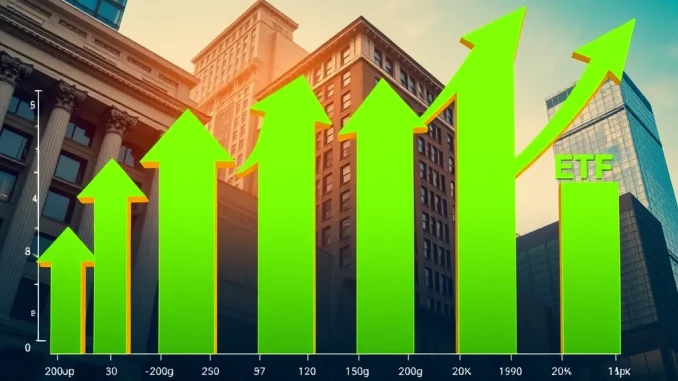
Buckle up, crypto enthusiasts! Even with Bitcoin experiencing some price turbulence, the forecast for Bitcoin ETFs is surprisingly bullish. Imagine this: despite a recent dip in Bitcoin’s price, analysts are predicting a whopping $3 billion inflow into spot Bitcoin ETFs in the second quarter of 2025. Yes, you read that right! Let’s dive into why this is happening and what it means for the future of crypto investments.
Bitcoin ETFs Defy Market Downturn with Strong Q1 Inflows
In the first quarter of 2025, spot Bitcoin ETFs demonstrated remarkable resilience. They absorbed over $1 billion in inflows. This is particularly noteworthy considering Bitcoin’s price took a 13% tumble during the same period, and the broader market showed signs of weakness. It’s like driving against the traffic, but in a good way! This robust performance signals strong underlying interest in Bitcoin exposure through these newly accessible investment vehicles.
Think about it – a billion dollars flowing in even when prices are down? That’s not just pocket change. It suggests that investors, particularly institutional players, are looking beyond short-term price fluctuations and focusing on the long-term potential of Bitcoin. This is a significant shift in market sentiment and adoption.
Why Institutional Demand is Driving Bitcoin ETF Inflows?
So, what’s the secret sauce behind this continued interest? According to Bitwise analyst Juan Leon, the primary drivers are rising institutional demand and easing regulatory concerns. Let’s break these down:
- Institutional Appetite: Major financial institutions are increasingly recognizing Bitcoin as a legitimate asset class. They are seeking regulated and accessible ways to incorporate Bitcoin into their portfolios. Bitcoin ETFs provide that perfect bridge, offering exposure to Bitcoin without the complexities of direct ownership, custody, and security.
- Easing Regulatory Landscape: As regulatory frameworks around cryptocurrencies become clearer and more favorable, institutions feel more comfortable entering the crypto space. The approval of spot Bitcoin ETFs itself is a testament to this evolving regulatory acceptance. This reduced uncertainty encourages larger investments and broader adoption.
Juan Leon’s projection of up to $3 billion in inflows for Q2 further underscores this trend. This forecast isn’t just based on wishful thinking; it’s grounded in the observable increase in institutional engagement and the improving regulatory climate.
Bitcoin ETF Inflows: Beyond Arbitrage to Long-Term Institutional Adoption
Initially, some analysts speculated that a portion of the Q1 inflows might have been driven by arbitrage strategies. Arbitrage involves exploiting price differences across different markets to make a profit. In the context of Bitcoin ETFs, this could involve trading between ETF prices and spot Bitcoin prices.
However, as yields from these arbitrage opportunities decline, the nature of ETF inflows is likely shifting towards genuine, long-term investment. This transition is crucial for the sustained growth and stability of the Bitcoin ETF market. It indicates a move from short-term tactical trading to strategic, long-term portfolio allocation.
CoinDesk reports that analysts believe long-term adoption by institutions and financial advisors is still in its early stages. This is a marathon, not a sprint. The current inflows, and projected future growth, are just the tip of the iceberg. The real potential lies in the continued integration of Bitcoin ETFs into mainstream investment portfolios.
What are the Benefits of Investing in Bitcoin ETFs?
Why are Bitcoin ETFs becoming so attractive, especially for institutions and financial advisors? Here are some key benefits:
- Accessibility and Convenience: Bitcoin ETFs are traded on traditional stock exchanges, making them easily accessible to a wide range of investors through their existing brokerage accounts. No need to set up crypto wallets or navigate complex exchanges.
- Regulation and Security: ETFs operate within established regulatory frameworks, providing a level of security and investor protection that may be lacking in direct crypto investments. This is particularly appealing to risk-averse institutions.
- Diversification: Bitcoin ETFs allow investors to diversify their portfolios with exposure to Bitcoin without directly holding the cryptocurrency. This can be a strategic advantage for portfolio managers seeking to enhance returns and manage risk.
- Tax Efficiency (Potentially): In some jurisdictions, ETFs may offer certain tax advantages compared to directly holding Bitcoin. Investors should consult with their tax advisors for specific guidance.
- Liquidity: Bitcoin ETFs are highly liquid, meaning they can be easily bought and sold during market hours, similar to stocks. This liquidity is crucial for institutional investors who need to manage large positions efficiently.
Navigating the Challenges: Risks Associated with Bitcoin ETF Investments
While the outlook for Bitcoin ETFs is bright, it’s important to acknowledge the inherent risks. Investing in Bitcoin ETFs, like any investment, comes with potential downsides:
- Volatility: Bitcoin itself is known for its price volatility. Bitcoin ETFs, being linked to Bitcoin’s price, will also experience significant price swings. Investors need to be prepared for potential sharp declines.
- Regulatory Uncertainty: While regulations are easing, the crypto regulatory landscape is still evolving globally. Changes in regulations could impact Bitcoin ETFs and the broader crypto market.
- Market Risks: Broader market downturns and economic factors can also affect Bitcoin ETF performance. They are not immune to macroeconomic trends and investor sentiment shifts.
- Management Fees: ETFs charge management fees, which can eat into returns over time. Investors should consider these fees when evaluating ETF investments.
Actionable Insights for Investors: Capitalizing on Bitcoin ETF Trends
So, how can you, as an investor, make the most of this Bitcoin ETF momentum?
- Due Diligence: Research different Bitcoin ETFs available in the market. Compare their fees, holdings, and trading volumes. Choose ETFs that align with your investment goals and risk tolerance.
- Long-Term Perspective: Consider Bitcoin ETFs as a long-term investment. Given the potential for institutional adoption and the evolving crypto landscape, a long-term view is more likely to yield positive results.
- Portfolio Diversification: Incorporate Bitcoin ETFs as part of a diversified investment portfolio. Don’t put all your eggs in one basket. Diversification can help mitigate risk.
- Stay Informed: Keep abreast of developments in the crypto market, regulatory changes, and Bitcoin ETF news. Informed investors make better decisions.
- Consult a Financial Advisor: If you’re unsure about investing in Bitcoin ETFs, seek advice from a qualified financial advisor. They can help you assess your risk tolerance and make informed investment choices.
Conclusion: A Stunning Future for Bitcoin ETFs?
The projected $3 billion inflow into Bitcoin ETFs in Q2, despite price dips, paints a compelling picture of the evolving crypto investment landscape. Institutional demand is clearly a powerful force, driving adoption and shaping the future of Bitcoin ETFs. As regulatory clarity improves and institutional interest deepens, Bitcoin ETFs are poised to play an increasingly significant role in the financial world. For investors looking to gain exposure to Bitcoin in a regulated and accessible manner, Bitcoin ETFs offer a stunning opportunity. Keep an eye on this space – it’s just getting started!



